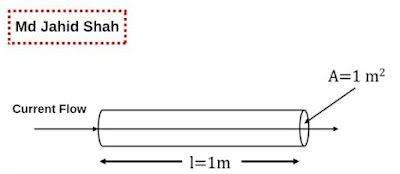 |
| Resistance and Specific Resistance |
A resistor is well-known as an electrical component that regulates or limits the flow of electrical current in an electronic circuit. Almost every circuit resistor is used, it mainly uses to reduce current flow, adjust signal levels, bias active elements, divide voltages, and terminate transmission lines, among other uses. it is a device that uses to produce resistance.
In simple words, When current flows through a conductor, it is interrupted by the conductor. This resistance is known as the resistance of the conductor. The S.I unit of resistance ohm. It is expressed by the symbol Omega Ω.
For example, 1 Ohm:
If the potential difference between the two ends of a conductor is 1 volt and a current of 1 ampere flows through it, the resistance of that conductor is called 1 ohm (1 Omega or Ω).
Resistance Formula:
The resistance of a conductor at a given temperature depends on the length and cross-sectional area of that conductor. There are two sources regarding this. Namely-
- The formula of length and
- The formula for cross-sectional area
Length formula:
The resistance R of a conductor is proportional to the length of the conductor if temperature, cross-section, and material are constant.
Therefore R is proportional to l,
∴R∝l ----------------(i)
The formula of the cross-section area:
 |
| The Formula of The Cross-Section Area |
That is R inverse-proportional to A,
∴R ∝ 1/A ----------------(ii)
Here "A" is defined as the cross-sectional area of the conductor.
Now substituting l and A we get from the above two formulas,
R∝ l/A
∴ R = ρ l/A ----------------(iii)
Here ρ is a constant.
It is called specific resistance or resistivity. The relative resistance or resistivity of a conductor depends on its material and temperature.
Consider the length of a conductor, l=1meter, and cross-sectional area, A=1square meter.
∴ From equation (iii) we get,
R = ρ 1/1 = ρ;
Hence, relative resistance can be defined as follows "The resistance of a conductor of unit length and unit cross-sectional area to the flow of current perpendicular to its cross-section is called its relative resistance".
Unit of Relative Resistance:
The unit of relative resistance is the ohm meter (Ω-m).
Resistance dependence:
The resistance of a conductor depends on four factors. Namely—
- Length of conductor
- The cross-sectional area of the conductor
- Conductor material
- Conductor temperature









No comments:
Post a Comment